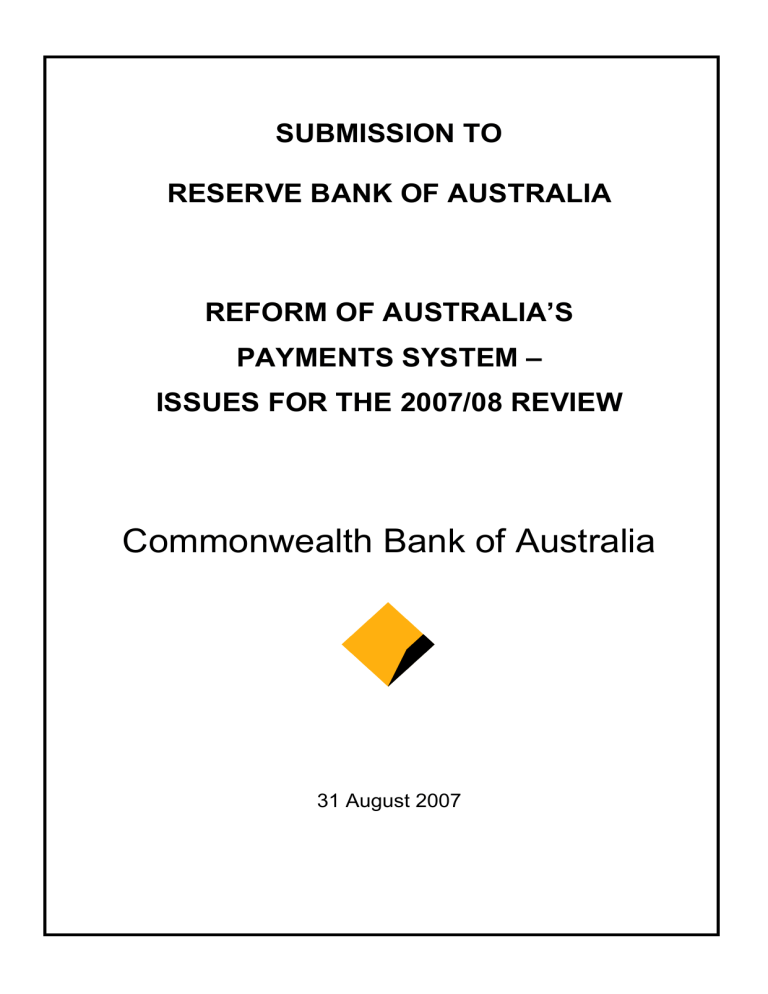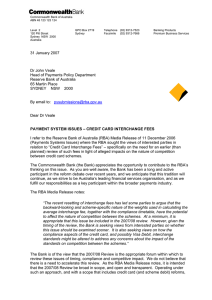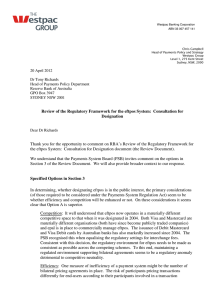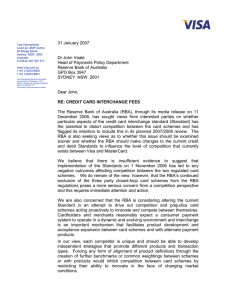SUBMISSION TO RESERVE BANK OF AUSTRALIA REFORM OF AUSTRALIA’S

SUBMISSION TO
RESERVE BANK OF AUSTRALIA
REFORM OF AUSTRALIA’S
PAYMENTS SYSTEM –
ISSUES FOR THE 2007/08 REVIEW
Commonwealth Bank of Australia
31 August 2007
1. INTRODUCTION
The Commonwealth Bank of Australia (the Bank) welcomes the opportunity to provide input to the Reserve Bank of Australia’s (RBA’s) 2007/08 Review of the Reform of Australia’s
Payments System. As a participant in Australia’s payment systems we want to ensure that these systems continue to deliver value to Australian consumers, businesses and governments.
We understand the Payments System Board is to exercise its authority in a way that “…will best contribute to controlling risk in the financial system; …promot[e] the efficiency of the payments system; and promot[e] competition in the market for payment services, consistent with the overall stability of the financial system.
1
”.
The RBA has sought views on three core questions:
•
What have been the effects of the reforms to date?;
•
What is the case for ongoing regulation of interchange fees, access arrangements, and scheme rules, and what are the practical alternatives to the current regulatory approach?; and
•
If the current regulatory approach is retained, what changes, if any, should be made to the standards and access regimes?
The Bank’s submission seeks to address the RBA’s core questions and specific issues in two parts:
•
Principles that the Bank believes should shape the approach to RBA’s decision making; and
•
Specific comments with relation to the individual payment systems identified by the RBA.
The Bank’s submission is based on the following principles:
•
Interchange Fees: Interchange Fees should be transparent, simple and relatively stable in terms of the basis for setting the level and the approach to future review. Networks form where benefits can be achieved by multiple participants operating in two-sided markets.
Interchange Fees are an important mechanism to promote speedy development of a network. Typically Interchange Fees flow toward the side of the market where an incentive is required to help the network reach critical mass quickly. Interchange Fees can (but do not necessarily need to) change over time to maintain/further develop a network or potentially more evenly distribute the network benefits between both sides of the market.
•
End-Pricing to Clients on Each Side of the Market : Participants in both sides of a market need to be able to maximise their network benefit by directly pricing to their customers in a way that is transparent and sensible from a customer perspective.
•
Maintenance of Payments System Integrity and Customer Utility: Participation in a payment network should be available to those that wish to join, subject to meeting appropriate prudential standards and controls to maintain system integrity, and on the basis that their participation adds value to the network. Equally, participation in a network should not necessarily be mandated. Payments participants should be free to determine how best to serve their customers.
1
Reserve Bank Act, 1959 (as amended), section 10B (3) (b).
Commonwealth Bank of Australia – Submission to the 2007-08 Review of Payments System Reforms Page 2 of 7
•
Network Self-Management: Where a payment network is built on the above principles, it is the Bank’s view that there is no need for regulation and that network owners/participants should be able to self-manage, with transparency in approach and review.
•
Regulator Intervention: Regulator intervention should only occur when there has been demonstrated market failure. Where there is evidence of market failure, any regulation should be transparent and provide certainty given the impact on innovation, ongoing maintenance investment and the cost of implementing regulated change.
•
Competitive Neutrality in Regulation: Where there is evidence of market failure, any regulation should be competitively neutral, that is, it should not favour one business or type of business over others. If an access regime is to be established that guarantees right of access to a network then those regulated to participate should, at least, be reimbursed for the economic costs incurred of supporting new entrants joining the network and any ongoing economic costs. This is consistent with the approach in the Trade Practices Act.
•
Economic Efficiency in Regulation: Where there is evidence of market failure, the Bank retains its view that a focus simply on current costs as a measure for economic efficiency is too narrow in terms of scope and timeframe. Any assessment of the efficiency of various payment systems should consider all relevant factors, in particular, the structure of the original development of those systems, the value ascribed by customers, relative capabilities of those payment systems and the incentives to invest.
We understand that the Australian Payments Clearing Association (APCA) is working toward developing principles for best-practice regulation of payment systems, in consultation with similar payments authorities world-wide. The Bank supports this work.
3. SPECIFIC COMMENTS ON PAYMENT SYSTEMS
CREDIT CARDS AND THREE-PARTY CARD SCHEMES
Observations
Since the introduction of the Credit Card standard in 2002 a number of changes to the provision of Credit Cards and Three-Party Card Schemes have occurred:
•
The demutualisation of MasterCard in 2006, and the planned demutualisation of Visa mean that these organisations will no longer be schemes overseen by network members.
This will improve the transparency of independence in the setting of Interchange Fees;
•
The removal of the No Surcharge rule (rather than the reduction in Interchange Fees) for
MasterCard and Visa, and voluntarily adoption by Amex and Diners, have allowed
Merchants to differentially price for Credit Card payments. A number of Merchants now surcharge for Credit Card payments. In some cases the level of surcharging by a
Merchant may be higher than the level of Merchant Service Fee that is being charged by the Merchant’s Acquirer. Other Merchants continue to provide price discounts to customers who make purchases with non-Credit Card instruments, which achieves a similar outcome to surcharging;
•
The removal of the Honour All Cards rule has also contributed to Merchants being able to effectively end-price to consumers. Since the removal of the No Surcharge rule, some of the Bank’s business customers have become more willing to accept Credit Card payments
(examples of merchant types can be provided to the RBA on request);
Commonwealth Bank of Australia – Submission to the 2007-08 Review of Payments System Reforms Page 3 of 7
•
Three-Party Card Schemes have a regulated advantage over Credit Cards that are subject to the Interchange Fee standard. This advantage arises from Merchants’ relative willingness to accept higher Merchant Service Fees because they can choose to pass these costs onto their customers through their product/service pricing or surcharging.
Therefore, Three-Party Card Schemes are able to charge higher Merchant Service Fees and provide higher incentives to Card Issuers to issue their cards than can MasterCard and Visa who are subject to an Interchange Fee standard;
•
Both Consumers and Merchants continue to value the provision of credit, an example being Merchants that offer “buy now, pay later” finance;
•
New Card Issuers and new Acquirers have joined the Credit Card networks and new types of Credit Cards have been marketed. These developments are evidence of continuing competition. Competition in Acquiring continues and is evident in the continuing decline of
Merchant Service Fees over the last few years, after the initial step change reduction that followed the introduction of the Credit Card Interchange Fee standard; and
•
Visa and MasterCard have separately introduced a complex array of Interchange Fees to encourage Card Issuers to sell particular types of Credit Cards and to promote Credit Card acceptance with selected types of Merchants. The Bank’s view is that this approach creates unnecessary complexity and reduces Credit Card utility when, in many cases, it is the same service being provided.
Recommendation to the RBA
The Bank considers that the removal of the No Surcharge Rule has facilitated end-pricing to clients on both sides of the market. MasterCard and (soon) Visa are now more clearly able to demonstrate independent setting of prices for their networks. However, there is not competitive neutrality with Three-Party Card Schemes.
Therefore, the Bank’s recommendation to the RBA is that MasterCard and Visa be given the ability to set Interchange Fees for their respective networks under the principles outlined above. Commitments from MasterCard and Visa to adopt a transparent and simpler approach that provides an appropriate degree of certainty for Card Issuers and Acquirers should be encouraged. A simpler approach would be expected to result in a reduction in Interchange Fee variants.
SCHEME DEBIT
Observations
MasterCard and Visa are currently seeking to build their Scheme Debit networks in Australia.
To encourage Card Issuers to sell Scheme Debit cards there are currently Interchange Fees paid from the Acquirer to Card Issuer. The RBA has set a standard that this fee is to be no more that 12 cents per transaction. Scheme Debit provides an alternative payment instrument to Debit Cards through the EFTPOS system and also provides some additional payment functionality.
The above comments relating to MasterCard and Visa ownership also apply to Scheme Debit.
Recommendation to the RBA
The Bank’s recommendation to the RBA is that MasterCard and Visa be able to set
Interchange Fees for their respective Scheme Debit networks. Commitments from MasterCard and Visa to adopt a transparent and simpler approach that provides an appropriate degree of certainty for Card Issuers and Acquirers should be encouraged.
Commonwealth Bank of Australia – Submission to the 2007-08 Review of Payments System Reforms Page 4 of 7
EFTPOS
Observations
The Interchange Fee standard for non-cash out EFTPOS transactions was introduced in 2006.
Given the extended period of regulatory uncertainty prior to the standard being set and now with the current RBA Review, Acquirers and Card Issuers continue to be understandably reluctant to develop the EFTPOS payment system. This has resulted in a lack of innovation and development of EFTPOS despite obvious opportunities (eg: online EFTPOS).
There is currently a proposal by the ABA to establish an EFTPOS Scheme that would seek to address this uncertainty and be responsible for the promotion and ongoing development of
EFTPOS. The Bank supports this work.
The separation of cash-out transactions from the standard that applies to purchase-only transactions is difficult to reconcile particularly given that Merchants have complete choice in providing a cash-out service (both whether to provide and when to provide if they have fluctuating cash levels). Therefore, the cash-out transaction is providing an additional benefit to
Merchants that is typically supported by a significantly higher Interchange Fee than the standard.
Regarding access to the EFTPOS system, the Bank continues to establish new interchange links with Card Issuers and Acquirers.
Recommendation to the RBA
The Bank recommends that the RBA support the establishment of an EFTPOS Scheme and on establishment, that the Scheme take responsibility for establishing and managing
Interchange Fees and access requirements. This should include aligning the Interchange Fees for cash-out transactions with purchase-only transactions.
BPAY
Observations
The BPAY Scheme continues to effectively self-manage. The Capture Reimbursement Fees are necessary both to recover initial innovation costs and to support ongoing operational and development costs for payer institutions. The Capture Reimbursement Fees were introduced on the basis of clearly articulated principles and are regularly reviewed with the support of independent experts.
Recommendation to the RBA
There is no need for regulatory intervention in BPAY. The Scheme should be allowed to continue in its current form and approach.
ATMs
Observations
Reform of the ATM network has been underway for many years in a number of forms. The
Bank has been an active participant in the reform process, as the industry has sought to address the RBA’s requirements for clearer access and pricing.
Commonwealth Bank of Australia – Submission to the 2007-08 Review of Payments System Reforms Page 5 of 7
The ABA has proposed a model to the RBA that allows for stronger guaranteed access for all
ATM Deployers and all Card Issuers, direct charging by the ATM Deployer and the setting of a zero Interchange Fee. We understand that the RBA is supportive of this model and has requested the ABA to consult with APCA to progress towards implementation.
Recommendation to the RBA
The Bank supports the ABA model and approach given the need for industry consensus on a way forward. The Bank recommends that the RBA continue to support the ABA and APCA in establishing a self-managed network.
4. OTHER ISSUES
Setting of Interchange Fees
Where the principles for payment networks outlined above can be demonstrated, it is the
Bank’s view that network owners/participants should be free to self-manage. This includes setting network pricing such as Interchange Fees.
The assumption by some that all Interchange Fees should be set to zero, or to a common level, is simplistic and would result in a significant decline in payments system innovation and development/maintenance. The zero Interchange Fee assumption implies that both sides of a market equally share the drivers to sustain a network, that it equally applies across all networks and that all networks are at the same stage of maturity. This is not correct.
The Bank does not agree with the suggestion that the RBA be provided with authority to set an
Interchange Fee standard without determining criteria and building a fact base to allow it to determine an appropriate Interchange Fee.
There have been examples where innovation and ongoing development of payment systems at an industry level have not occurred (eg: EFTPOS development) largely due to the uncertain regulatory environment. This has had the potential to reduce competition between payment networks. Where there has been effective self-management (eg: the BPAY scheme) innovation has been stronger.
There have also been business opportunities within the Bank that have not progressed due to the level of regulatory uncertainty (examples can be provided to the RBA on request).
Access
The Bank notes that there are now clear guidelines for access to all of Australia’s current payment networks (including the current work to provide greater clarity to ATM network access). The Bank supports open access to payment networks, but notes the importance of the RBA and APRA maintaining ongoing discussions regarding payment systems stability and prudential issues.
The Bank supports the development of new payment networks. This includes the ability to direct transactions through whichever network provides the best benefits for the Bank’s customers.
Commonwealth Bank of Australia – Submission to the 2007-08 Review of Payments System Reforms Page 6 of 7
New Technology
Payment system technologies develop rapidly. New technologies are introduced from time to time which can change the economics of payment networks (eg: EMV chip cards).
Prescriptive regulation that defines outcomes rather than principles has inherent risks of remaining static with technological and environmental change. This has the potential to introduce significant imbalances in networks over time, even where imbalances are not present in original regulation. This further supports self-management by network owners/participants where the principles outlined above are in place.
Pre-paid Cards
There is growing interest in the development of pre-paid cards. The nature of pre-paid cards is most like debit transactions through EFTPOS and Scheme Debit, as opposed to Credit Cards.
Given that the market is currently relatively small, the Bank’s view is that any regulation will retard innovation and market development.
The Bank would welcome the opportunity to discuss its views with the RBA as the Review progresses.
Commonwealth Bank of Australia
31 August 2007
Commonwealth Bank of Australia – Submission to the 2007-08 Review of Payments System Reforms Page 7 of 7




